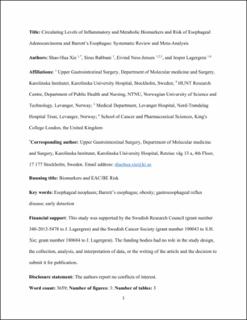| dc.description.abstract | Associations between circulating levels of obesity-related biomarkers and risk of esophageal adenocarcinoma and Barrett esophagus have been reported, but the results are inconsistent. A literature search until October 2018 in MEDLINE and EMBASE was performed. Pooled ORs with 95% confidence intervals (CI) were estimated for associations between 13 obesity-related inflammatory and metabolic biomarkers and risk of esophageal adenocarcinoma or Barrett esophagus using random effect meta-analyses. Among 7,641 studies, 19 were eligible for inclusion (12 cross-sectional, two nested case–control, and five cohort studies). Comparing the highest versus lowest categories of circulating biomarker levels, the pooled ORs were increased for leptin (OR, 1.68; 95% CI, 0.95–2.97 for Barrett esophagus), glucose (OR, 1.12; 95% CI, 1.03–1.22 for esophageal adenocarcinoma), insulin (OR, 1.47; 95% CI, 1.06–2.00 for Barrett esophagus), C-reactive protein (CRP; OR, 2.06; 95% CI, 1.28–3.31 for esophageal adenocarcinoma), IL6 (OR, 1.50; 95% CI, 1.03–2.19 for esophageal adenocarcinoma), and soluble TNF receptor 2 (sTNFR-2; OR, 3.16; 95% CI, 1.76–5.65 for esophageal adenocarcinoma). No associations were identified for adiponectin, ghrelin, insulin-like growth factor 1, insulin-like growth factor-binding protein 3, triglycerides, IL8, or TNFα. Higher circulating levels of leptin, glucose, insulin, CRP, IL6, and sTNFR-2 may be associated with an increased risk of esophageal adenocarcinoma or Barrett esophagus. More prospective studies are required to identify biomarkers that can help select high-risk individuals for targeted prevention and early detection. | en_US |
